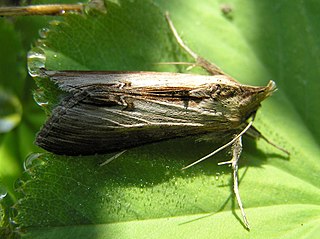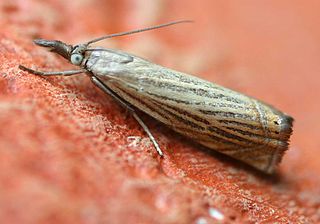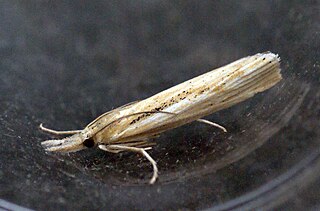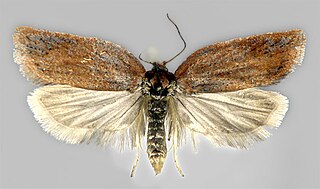
Argyresthia albistria is a moth of the family Yponomeutidae. It is found in most of Europe.

Cucullia asteris, or star-wort, is a moth of the family Noctuidae. The species was first described by Michael Denis and Ignaz Schiffermüller in 1775. It is found through the Palearctic including Japan.

Agriphila latistria is a species of moth of the family Crambidae. It is found in Europe, but originates from the area surrounding the Mediterranean Sea.

Agriphila straminella is a species of moth of the family Crambidae. It was described by Michael Denis and Ignaz Schiffermüller in 1775 and is found in Europe and east across the Palearctic.

Agriphila selasella is a species of moth of the family Crambidae. It was described by Jacob Hübner in 1813 and is found in Europe and east across the Palearctic.

Pyrausta despicata, the straw-barred pearl, is a species of moth of the family Crambidae. It was described by Giovanni Antonio Scopoli in his 1763 Entomologia Carniolica.

Pyrausta sanguinalis, the scarce crimson and gold, is a moth of the family Crambidae. The species was first described by Carl Linnaeus in his 1767 12th edition of Systema Naturae. It is found across western Europe as far east as southern Finland. In the British Isles it was formerly found at multiple coastal locations in north-west England and Scotland, however it has now much declined and it is restricted to a few locations in Northern Ireland, in the west of Ireland, and a single site on the Isle of Man.

Catoptria margaritella, the pearl-band grass veneer, is a species of moth of the family Crambidae. It was described by Michael Denis and Ignaz Schiffermüller in 1775 and is found in Europe.

Catoptria pinella is a species of moth of the family Crambidae. It is found in Europe, North Africa and across the Palearctic.

Catoptria verellus is a species of moth of the family Crambidae. It is found in Europe.

Chrysoteuchia culmella, the garden grass-veneer, is a species of moth of the family Crambidae. It was first described by Carl Linnaeus in his 1758 10th edition of Systema Naturae. It is found in Europe.

Crambus pratella is a species of moth of the family Crambidae. It is found in Europe and Asia Minor.

Pediasia aridella is a species of moth of the family Crambidae. It was described by Carl Peter Thunberg in 1788 and is found in Europe. There are three recognised subspecies.

Platytes alpinella is a species of moth of the family Crambidae described by Jacob Hübner in 1813. It is found in Europe, the area surrounding the Caucasus and the eastern part of Russia.

The flame wainscot is a species of moth of the family Noctuidae. It is found from Europe and across the Palearctic to Japan, but is not found on the Iberian Peninsula, the islands in the Mediterranean Sea, Greece and central and southern Italy.

Polia bombycina is a moth of the family Noctuidae. It is found in the Palearctic realm from Ireland to Japan including the Russian Far East and Siberia.

The honeysuckle moth is a moth of the family Ypsolophidae. It is found in Europe, Anatolia, north-eastern China, Russia and mideast Asia. It is also present in North America, where it is known from the eastern United States and southern Canada.

Leucania loreyi, the cosmopolitan, false army worm or nightfeeding rice armyworm, is a moth of the family Noctuidae. It is found in most of African countries, the Indo-Australian subtropics and tropics of India, Sri Lanka, Myanmar, the eastern Palearctic realm, and the Near East and Middle East. The species was first described by Philogène Auguste Joseph Duponchel in 1827.

Acleris rufana is a moth of the family Tortricidae. It is found from northern, central and south-western Europe through southern Siberia to the Russian Far East and Japan.

Orthotelia is a genus of moths in the subfamily Orthoteliinae.Orthotelia sparganella, a moth of the family Glyphipterigidae, is its only species.






















